Since we have had a six-week stretch of amazingly beautiful weather, although to be truthful a day or two of rain would also be nice, I’ve taken some time to go strolling through the woods, trolling for firewood. Here’s the standing inventory of firewood just awaiting harvest within about a hundred yards of the cabin or barn. Expend the perimeter farther and the inventory grows proportionally.
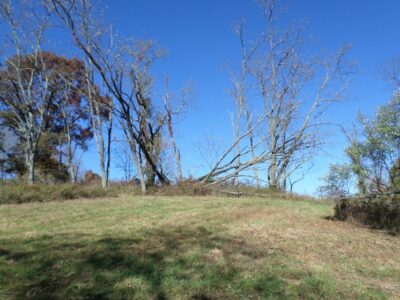
Just above the site of the old shack, recently cleaned up and ready for bush hogging itself, is this cluster of trees from a storm last winter. All tolled I think there are eight long trunks, each around a foot in diameter. Definitely a couple little truck loads. I think these were birches but will confirm with my chainsaw.
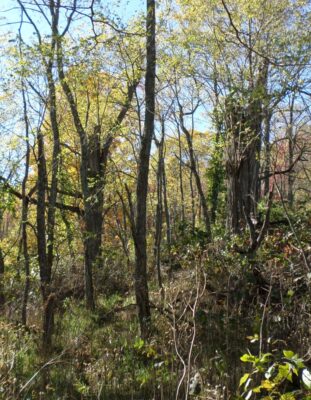
Along the same ridge line, about fifty yards above the cabin is this magnificent pair of locust trunks. The tops were snapped off in a windstorm maybe three winters ago. You can just barely make them out in the picture. The trunk on the right is massive, perhaps a dozen feet or more in girth. The one on the left is about eight feet in in girth. Both will require the manly chainsaw of my pal Bob, who will come and fell them some time this winter. If the wood is sound I might try to split them into fence rails. If they are not good for that they will become most excellent firewood, probably two winters’ worth.
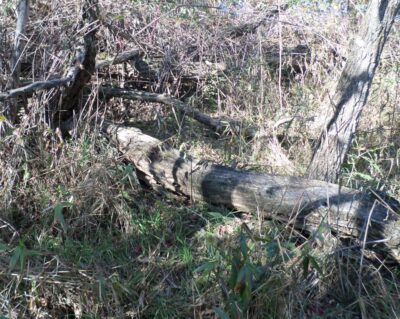
The tops of those two trees are laying scattered on the ground and I will harvest them in the coming weeks. Since they are locust they could be downed for many years and still be good firewood. This hunk is almost two feet in diameter.


Working west along the same ridge line about 100 yards from the cabin is this pair of mighty big trees, brought down in the same storm as the first cluster in this post. All of the major trunks are 16″-18″ in diameter. One is cherry, I cannot recall what the other one is. Either way that is one honkin’ big pile of firewood.
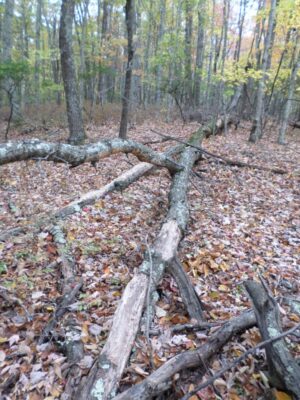
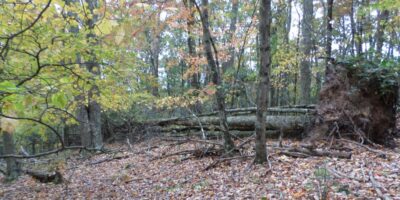
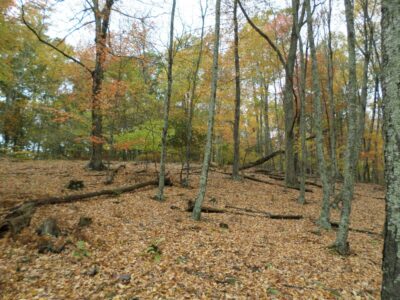
Moving around to the hill up behind and within sight of the barn is another cornucopia of BTUs. The first picture is of a maple, the second a cherry, and the trunks strewn about in the third picture are all locust.
I can hardly wait to turn my little chain saw loose on cutting all this up and stacking it in the staging area. But it has to wait until I get all done with the greenhouse.
With the wire frame tunnel in place it was time to frame out the ends. It was not as easy as I had hoped given that the perfect semi-circular arc was not, well, perfect. Nor was it even symmetrical for both ends. Mostly a semi-circular arch, but not perfect. That meant that every stick had to be custom cut and fit before assembling with deck screws. plus, the pile driver/local rocky dirt combination meant that the posts themselves were out of perfect by about an eighth of an inch. All of that compounded to make sure the assembling of the end framing was a tedious process.
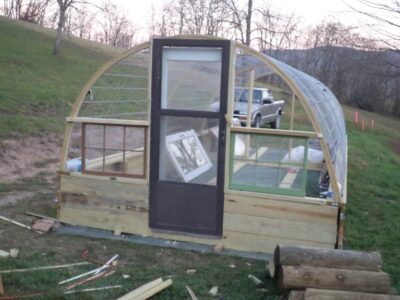
I did have the advantage(?) of lots of recycled windows and doors. When you have replaced all the windows in two houses, you’ve got plenty of inventory. There are two doors at each end, one screened and the other glass. All of the windows will be openable as screened awning windows once the weather is right in the early summer (our “frost free” date is May 30).
Notwithstanding the fact that the arch at the east end of the space was 2″ off-axis due to whatever factor — lunar forces, prevailing trade winds, inherent torque in the raw material — it was an easy enough problem to rectify once I recognized it.
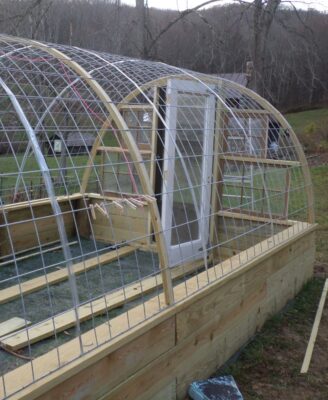
Compounding all of the tedium was that we were at the time of year when I lose usable working light by about 4PM, at least “usable” for these tired old dysfunctional eyes. But after about four days of effort the ends were framed and mostly glazed. I say “mostly” because we are awaiting the arrival of the solar ventilation fan to get installed before everything gets buttoned up.
At least you get the idea.
Up next; draping the plastic. Stay tuned.
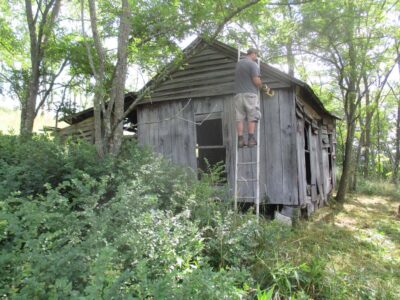
With beautiful autumn weather in the air and the hillside bush hogging (mostly) completed, for a couple days I turned my attention to the last remains of the shack that was once someone’s home a hundred years ago. My brother, nephew and I dismantled and salvaged a great deal of the lumber from the building nine (!) years ago before I was so rudely accosted by a wheelbarrow and the whole project was interrupted. By the time I had recovered fully from my broken hip it was late winter and the inspiration to finish the task had passed.
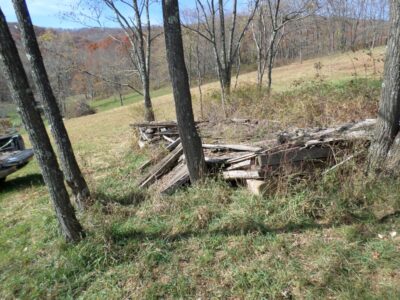
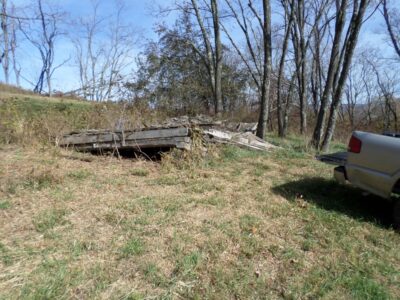
Flash forward to now.
As I was wrestling the bush hog around the site recently, I thought the time had come to finally clean up the mess. I had hoped that there might be some last vestiges to salvage, even if for nothing other than firewood, but that was not the case for 99% of the detritus. It just all needed to be piled in the truck and hauled to the burn pit at the dump.
Three heaping truckloads later all that was left were two large timbers. These were the only elements worth salvaging, and even then it was just for firewood. It’s a real shame, as they were still bearing the axe marks of the men who made this home probably around 1900 or so.

As I assembled the “tunnel” of the greenhouse from the cattle panel fencing I noted a lot of wiggle in the structure, even after tying all the sections together with zip ties at their edges. Yeah, yootoobers swear it can withstand fierce winter weather but my friend Floyd over on the east side of the county, and whose greenhouse was absolutely the inspiration for this one, indicated that our occasional heavy snow (~18″) caused him some problems. Being the over-builder that I am, I decided to add curved ribs inside the tunnel to beef it up.
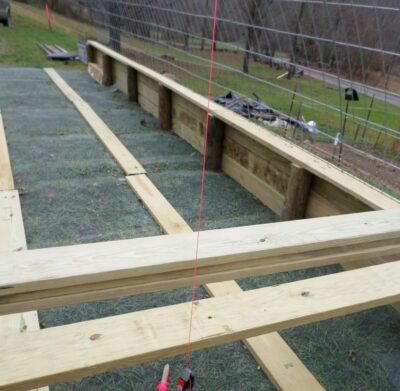
My first step was to configure to tunnel to be symmetrical which required aligning the center of the arched panels with the center line of the overall structure. Using a simple plumb bob I pushed and pulled the sections to be at least along the same center line. I’d hoped that this combined with the rib-building process would make all the arch curves identical.

With string lashing to keep the arches aligned with the center line, along with diagonal wooden braces, I set about the task.

Using my little table saw more than I have in a long time I sliced off a pile of 3/16″ strips to build the laminations. For the most part simply clamping the strips to the underside of the arches imposed a semi-circular arc, and this was enhanced by the continued build-up of the laminations.


A combination of spring clamps by the bushel, T3 glue and a multitude of crown staples the ribs began to take shape. The enhanced structural robustness became increasingly clear as the glue dried, which took about three days given the moisture content of the PT SYP lumber strips and the weather itself.

All in all it took me almost three days to get the 10-layer ribs finished, but they are now in place for the next step, framing in the ends of the tunnels and adding doors and windows.


Seriously, the structure is now strong enough that I could crawl all the way to the top to staple the fence grid to the ribs.
The conceptual core of this greenhouse design is an arched tunnel made from heavyweight metal grids, known as “cattle panels [fencing].” In fact that is what the product is used for, to fence cows in or out, and it is robust enough to withstand the rubbing of cattle against it. Even our little feed-and-seed hardware store in the middle of the least populous county east of the Mississippi has a stack of it out in the yard, and since the dimensions are 52″ x 16′ I was glad they could and did deliver it to the greenhouse site.

Unfortunately I failed to get a picture of my pile of eight panels, but here is one lying on the ground. They are #6 gauge so plenty stout.

These panels are not heavy but they are unwieldy. Think of trying to handle a full sheet of 1/4″ luan plywood in a windstorm. Once I got the hang of handling these panels and setting them in place on top of the knee walls it went fairly quickly. I first strung parallel lines on top of the wall sills, then drove in nails along those lines. The nails were proud about an inch to “catch” the ends of the fence panels as I placed them where they belonged. In an hour or so they were all in place.

I drove fence staples all along the bottom edges of the panels then joined the panel edges together with zip ties along the joints to yield a single 30-foot panel from the multiple individual four-foot panels.

This is going to be a marvelous addition to the homestead.
Most folks building this style of greenhouse simply drape it with plastic at this point, assuming (correctly) that the arched configuration could withstand all manner of problematic weather. I know this to be true but it felt a little flimsy to me, so I decided to build structural ribs to enhance the robustness of the arch.
That’s what comes next.
Three Saturday’s ago I went to our friends Pat and Valerie for their annual apple butter day. It’s a local tradition that we have gladly glommed on to.
Great fun and fellowship abounded.
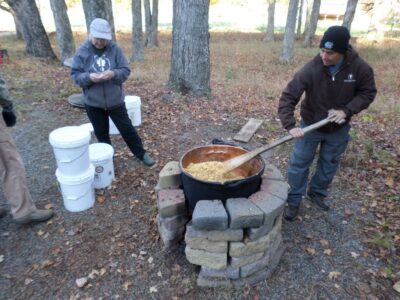
At the start, apple chips are just dumped into the copper cauldron and stirred with a canoe paddle.

There is a lot of standing around while we watch the person with the paddle. This is where the tall tales and gripes about taxes emerge.
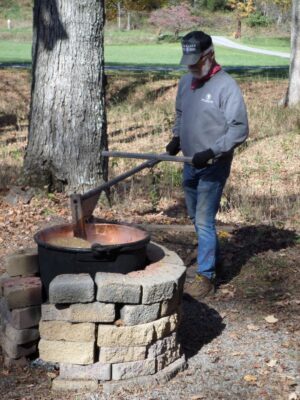

As it cooks down more apple chips are added and the stirring switches to a custom designed stirring paddle.
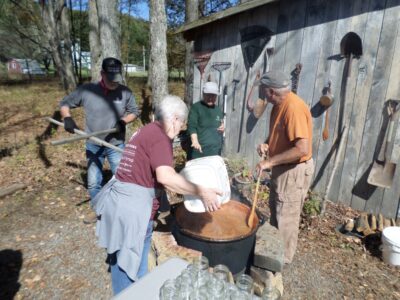
Hours later it is all cooked down and ready for adding the spices and sugar. Occasionally they make a batch of sugar free apple butter, that is the stuff we like. But this was a sugared batch.
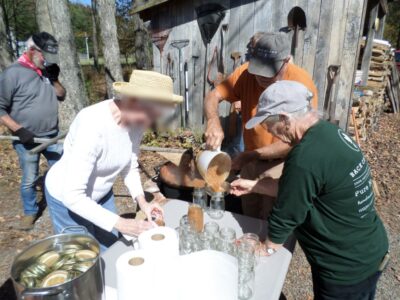
Once that is all cooked and stirred some more, Pat conducts an “all finished” viscosity test by depositing a dollop on the underside of a sauce pan. Too runny? Cook some more. When it is ready it gets canned in jars.

At this point my job was to carry the cases of still-hot jars into the sugar house for later labeling and, eventually, selling.
The big highlight is that after all the work is done, Pat’s sister breaks out the bin of fresh, still-warm biscuits we use to scrape the residue out the cauldron. The moaning of delight commenced.
Mmmm, mmmm, mmm.


With stout posts driven 36″+ into the ground I was ready to move forward and ordered the requisite 1/4″ hardware cloth to cover the entire floor space (to keep out all the little rodents that make Mrs. Barn’s gardening life one of frustration) and the pile of 2x8x10′ PT/SYP to build the knee walls and other components. Now that was a shock, as the price was 3X more than the last time I ordered any meaningful quantity of construction lumber. Those who are Inflation Deniers clearly do not comprehend either the definition of the term nor its manifestation. But Don, are you saying you are smarter than the President and Secretary of the Treasury and Chairman of the Federal Reserve and all those other “experts”?
Yup. Why that is would be another blog post, or better yet, in some other universe of discourse. Hint: it all boils down to the “Austrian” strain of economics.

I laid the hardware cloth and began screwing the 2x8s to the posts. I bought enough material for a four-course wall but Mrs. Barn decided three was better, so I managed to build my reserve inventory of that supply even more.

With the three courses in place, I fired up the chainsaw and lopped off the posts at the top of the knee wall. Carpentry by chainsaw is definitely a thing. Those scraps will become bench legs in the greenhouse configuration.
Setting the edge with string I lined up all the sill plates on top of the walls and posts, readying everything for the addition of the cattle fence panels that will form the arched roof structure.
Stay tuned.
We are smack-dab in the middle of a fortnight-plus stretch of simply spectacular weather, sunny days in the 60s and nights in the 30s and 40s. we are taking full advantage of the opportunity to get tons of outside work done. Matter of fact I have not been in the shop for nearly three weeks other than to package orders for mailing out.
Thanks to our connection to a stout young local lad, we’ve been able to keep up with the routine yard work much better than years past. One of the things we really appreciate is his mowing of the large hillside area directly above the garden. It keeps the underbrush under control and the expanse of green is a delight.
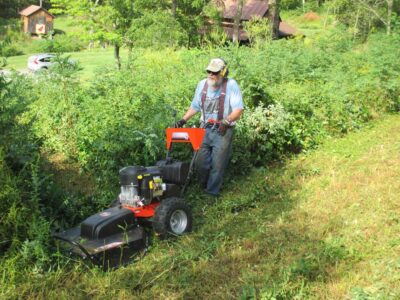
A picture from eight years ago when I first got the beast.
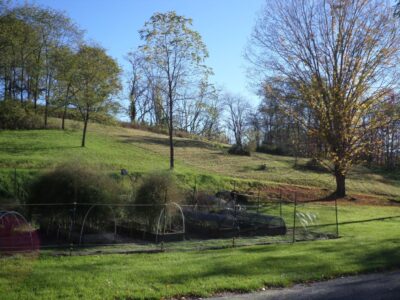
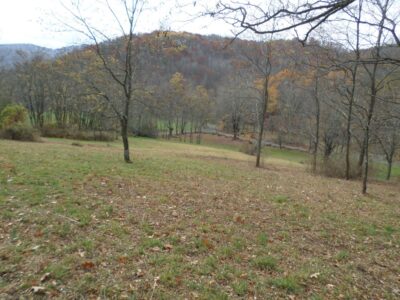
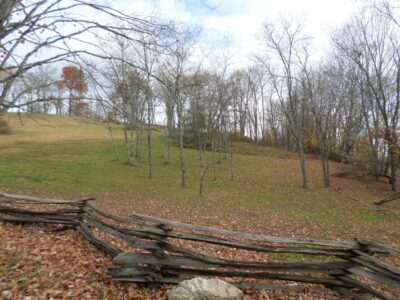
In order to expand that vista and perhaps make more space available for other things, an orchard is in the discussion, I spent several days with my DR Brush Mower whacking away at the ~4 acres of hillside adjacent to this mowed area. It’s the brown-ish area just beyond the green. I can only work on this about every third day as my shoulders need a lot of recuperation time these days.
For the first time since we bought the property almost 25 years ago that section of hillside is all cleared except for the woodland we are keeping. With this step our young fellow is certain he can keep that area mowed as well. There is definitely a difference between a cautious old man with a $4K lawn tractor and a fearless 16-year-old with a $10K lawn tractor.
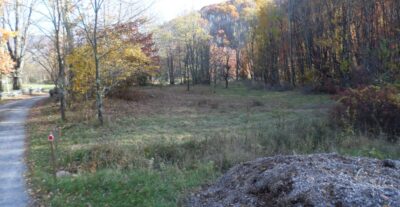
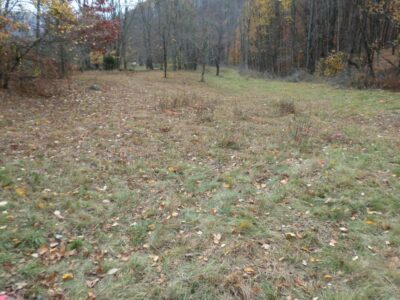
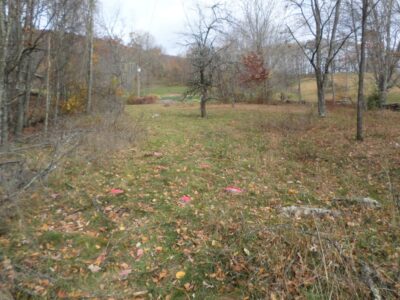
In addition I cleared a 1-1/2 acre section between the driveway and the creek, an area we always called “the orchard” since there were a few apple trees there. That field is chock full of large rocks and I walked it ahead of time, marking each big rock with fluorescent spray paint. It was still several hours of arduous work, with many more hours of work yet to come.
Because of our brutal drought this gardening season (no meaningful rain from April until September) Mrs. Barn spent untold hours delivering water to her thirsty garden, generally twice a day. Some of the plants still suffered but still she managed to grow and gather quite a bounty.
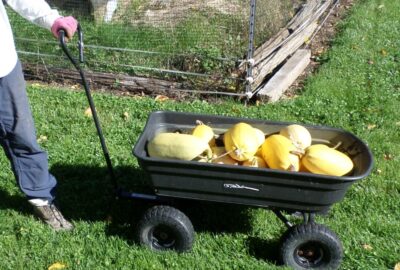
Here is a wagonload of spaghetti squash, one of our favorites. Maybe enough for all winter.
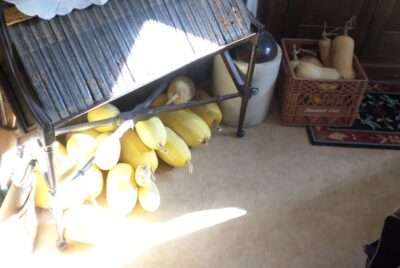
The winter’s inventory of squash resides under the vintage encyclopedias in the dining room
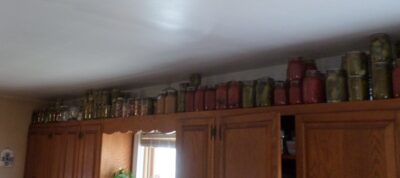
And a portion of the canned veggies and salsa.
We are very much looking forward to next gardening season with the new greenhouse fully in service. Real construction begins tomorrow!
Last Saturday was an exciting eventful day at the homestead as a long-delayed project got off the ground (well, in the ground).
A few weeks ago I was chatting with my friend KC about our way-behind-schedule plans for building a greenhouse on the terrace we had cut into the hillside two years ago. From my perspective one of the big hurdles was building up the enthusiasm and energy to dig 14 three-foot-deep holes for the 6-inch fence posts I was planning on using for the foundation to the knee-walls.
“No problem,” sez KC, “I’ll just bring over my post driver and we will get it done in a snap.” As a farmer/rancher with probably miles of fencing, KC owned a portable pile driver. It probably should not have surprised me, but I actually did not know such a machine ever existed.

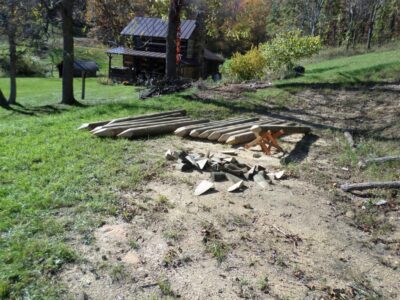
Last week I laid out the greenhouse footprint and cut points into one end of the posts. This made it much easier to get them into the ground straight, provided we didn’t encounter a large subterranean rock during the driving. Ironically the first post was the only one that drifted crooked during the whole process.
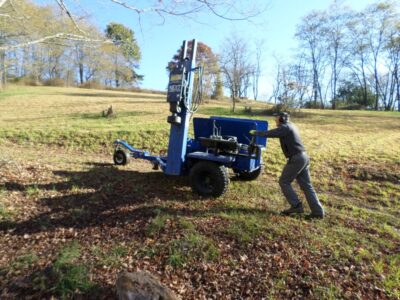
He showed up at 9AM as promised and left around 90 minutes later. I suspect it would have taken me a month or two to accomplish the same work by hand.
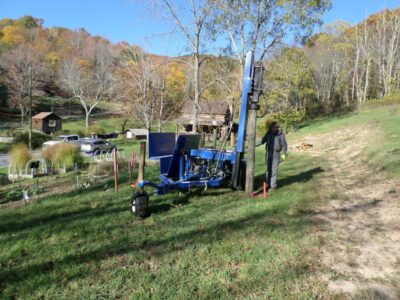
We placed the posts where I had marked the ground, set up the machine to capture the top, used a level for both the X and X’ axes, he threw the switch, and the ground started shaking. BAM, BAM, BAM with the speed of a jackhammer.

Like I said he was done and out the driveway about 90 minutes later.
The project will resume as soon as I can get a truckload of pressure treated SYP delivered to build the knee walls.





















































Recent Comments